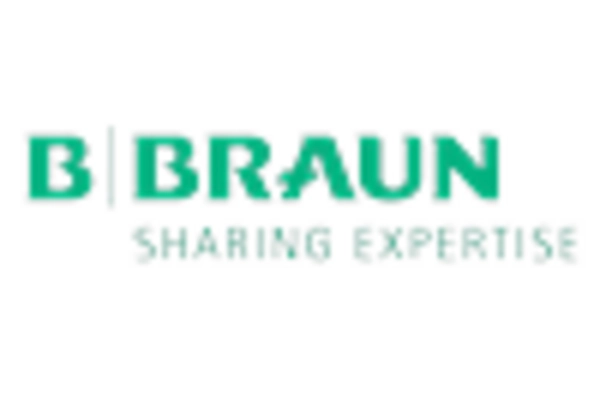Rising Incidence of Cardiovascular Diseases
The ablation devices market is significantly influenced by the rising incidence of cardiovascular diseases in the US. Statistics indicate that nearly 697,000 individuals die from heart disease annually, making it a leading cause of mortality. This alarming trend has led to an increased focus on effective treatment options, including catheter ablation procedures, which are essential for managing arrhythmias and other heart conditions. The market for ablation devices is projected to grow as healthcare providers seek innovative solutions to address this public health crisis. Moreover, the American Heart Association emphasizes the importance of early intervention, which further supports the adoption of ablation technologies. As the prevalence of cardiovascular diseases continues to escalate, the ablation devices market is poised for substantial growth, driven by the urgent need for effective therapeutic interventions.
Technological Innovations in Ablation Devices
Technological innovations are playing a pivotal role in shaping the ablation devices market. Recent advancements, such as the development of radiofrequency and cryoablation technologies, have enhanced the precision and effectiveness of ablation procedures. These innovations not only improve patient outcomes but also reduce procedural times, making them more efficient. The market is witnessing a shift towards devices that incorporate advanced imaging techniques, allowing for better visualization during procedures. As a result, healthcare providers are increasingly adopting these state-of-the-art devices, which are expected to capture a larger market share. Furthermore, the integration of artificial intelligence and machine learning into ablation technologies may further revolutionize the field, leading to improved decision-making and patient care. The ongoing technological evolution is likely to be a key driver of growth in the ablation devices market.
Increasing Demand for Minimally Invasive Procedures
The ablation devices market is experiencing a notable surge in demand for minimally invasive procedures. Patients and healthcare providers are increasingly favoring these techniques due to their associated benefits, such as reduced recovery times and lower risk of complications. According to recent data, minimally invasive surgeries account for approximately 60% of all surgical procedures in the US, indicating a strong preference among patients. This trend is likely to drive the growth of the ablation devices market, as these devices are integral to performing such procedures. Furthermore, advancements in technology are enhancing the efficacy and safety of these devices, making them more appealing to both practitioners and patients. As the healthcare landscape continues to evolve, the demand for minimally invasive options is expected to further propel the ablation devices market forward.
Growing Awareness and Education on Treatment Options
The ablation devices market is benefiting from a growing awareness and education regarding treatment options among both healthcare professionals and patients. Increased access to information through digital platforms and healthcare campaigns has empowered patients to seek out effective treatments for their conditions. This heightened awareness is particularly evident in the context of arrhythmias and chronic pain management, where ablation procedures are often recommended. As patients become more informed about the benefits and risks associated with these procedures, they are more likely to discuss ablation options with their healthcare providers. Consequently, this trend is expected to drive demand for ablation devices, as more patients opt for these innovative solutions. Additionally, healthcare providers are increasingly incorporating ablation techniques into their practice, further contributing to the growth of the ablation devices market.
Supportive Reimbursement Policies for Ablation Procedures
Supportive reimbursement policies are emerging as a crucial driver for the ablation devices market. In the US, insurance coverage for ablation procedures has expanded, making these treatments more accessible to patients. This shift is likely to encourage more healthcare providers to offer ablation services, knowing that patients can receive financial support for their procedures. The Centers for Medicare & Medicaid Services (CMS) has recognized the efficacy of ablation techniques, leading to favorable reimbursement rates that incentivize their use. As reimbursement policies continue to evolve, they are expected to play a significant role in shaping the landscape of the ablation devices market. This supportive environment may lead to increased investment in research and development, further enhancing the capabilities and applications of ablation technologies.

















Leave a Comment